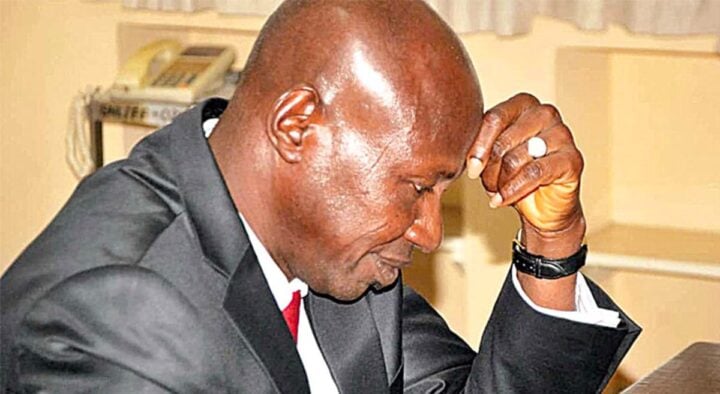BY TOMBARI SIBE
A good leader always looks out to share knowledge and opportunities. Like a brilliant number 10 and playmaker in the game of soccer, he brings others into the game and looks for an opening to give a defence-splitting pass for a teammate to score. This is the stuff of leadership, and this is what this book documents.
The book is a condensed commentary from a leader who has recorded remarkable successes, failed in some instances along the way, picked himself up and made it a duty to get better. It is the story of a leader reputed for turning around failed enterprises as well as having a knack for spotting and nurturing SME’s.
The book de-emphasizes what has become the regular leadership cliché, and opted for the language of experience presented in a dialogic and conversational tone. Perhaps, knowing that the many leadership books hanging on bookshelves are heavily laden with theories, the author adopted a practical approach, which sets it apart from the others.
Advertisement
Each page is a collection of life lessons for different scenarios. In building brands, for instance, the author admonished Nigerians to build businesses that will outlive their generation. Citing the case of the Arthur Guinness family, the author shared the remarkable story of how the enterprise was handed down generations, through vision, faith, values and commitment.
In reading this, I remembered my own encounter with the Guinness family. No, not through the bottle of Guinness Stout which was our first meet, but subsequently through the famous Student T-Test, while doing inferential statistics. William Sealy Gosset was a scientist and master brewer of Guinness. He created the Student’s T-tests in 1908 to solve the challenge of ensuring the right quality of stout. This was a groundbreaking solution in inferential statistics, and Guinness allowed him to publish it in a peer-reviewed journal under the pseudo name, “Student” so the competitors will not have an idea this was all a calculation for the right type and quantity of raw materials. It is still being applied in inferential statistics more than a century later. Not only did their brew and enterprise survive centuries, they also contributed uniquely to the body of knowledge. This underscores the depth of their value for research and development; something that perhaps, spurred the author to set up what he called the “Refinery” – a training school for Heritage Bank.
The author made a brilliant analogy of the processes in the fractional distillation column of a refinery, and the process that distils an individual from his raw talent into a fine leader. The book likens the training school set up for Heritage Bank as the refinery. Leadership needs to go through such catalytic cracking to refine the attributes and qualities from the crude form. In setting up the refinery, the author did not settle for an artisanal refinery for quick fixes, with attendant environmental impact. Rather, he invested in efficient “fractional distillation columns” for human resource, to refine the leaders he needed to run the organization, prosper and hand it to the next generation. Sustainability! He set up a solid training school that reached beyond just banking, to teach etiquette, relationship, social assets, law, and many more. He wanted well-rounded leaders.
Advertisement
The book stirs up an interesting conversation of globalization and the hybrid form, glocalization. The author admonished young people to substitute the mindset of globalization with that of glocalization, so they can customize their global outlook to solving local problems. This is an interesting perspective which I consider very apt for Nigerian youths who want to hit the international headlines without first making headlines in their local ecosystem. The pathway to global success should be facilitated by the local problems you solve. According to the author, this is what sets the likes of Jack Ma apart.
An interesting experience shared by the author in this book is the revival of the dead bank, Societe Generale Bank. Reviving a failed bank in any country of the world is never easy. In Nigeria, this is even more difficult. In fact, it could be as difficult as raising the dead. You will need the faithful sisters Mary and Martha, as well as the son of God, all present and joined together in faith, to perform that miracle. And yes, that did happen; not literally, but in some sense. The author and his team (the Mary’s and the Martha’s) apart from the vision, commitment, positive thinking and resources, also relied on faith. Yes, you need faith to dream of getting over 200 bank customers to withdraw their cases in a single day, and settle out of court. This account was intriguing, and loaded; albeit, told with such simplicity that demystified what ought to be a complicated success story.
The author reached for examples, case studies, and scenarios from different perspectives. He reached for the Bible; quite often, I should note. Not surprising, as a section of the book was on the role of faith in leadership. In one analogy he cited the power of single-mindedness and unity of purpose as exemplified in the Biblical tower of Babel, which struck a chord with me. I have often used this analogy while teaching the role of Protocol in Computer Communications and Networks, and it epitomizes the power of a common understanding and mindset. Once a team is united and has a single mindset, it is difficult to defeat it. God identified this in the case of the Tower of Babel. The author highlighted this as an important ingredient for success in the corporate space.
The book has several “Take Action” stopovers after each chapter; where readers are refreshed with simplified but impact-filled action points. The lessons that follow each are drawn from the real world of successful business enterprises. So much was covered in such short space. Some of these include lessons on the complexities of the world of mergers and acquisition; lessons on dealing with soft issues; lessons in Emotional Intelligence; lessons on having the right mindset; lessons on visioning and the kinetics of visioning; lessons in entrepreneurship; the importance of hitting the road, and gaining traction.
Advertisement
Most of the leadership books I have read, particularly those written from self-experience, only amplify the successes of the author. In this book, the author did not hold back on the failings and challenges he encountered on his way up. From his successful revival of SGBN (a massive success by any metric) to the creation of Heritage Bank, and to the quick-fire acquisition of Enterprise Bank – which turned to be a poor decision on timing. The author shared these lessons to illuminate the path of the reader, so the mistakes are not repeated. Mistakes are not to be buried and filed out of memory; they can be converted to steps on the ladder on the way to the top. They form part of the script of success.
On a personal note, this book explained a lot I had always tried to understand about the author. I have quietly observed his calm demeanour, positive disposition, and deliberate accessibility, despite such a busy schedule and demands of holding such an exalted office. In my career, I had two cameo roles in two different banks, and understand the glory of the office of the MD. I also saw first hand, the palpable tension in the banking workspace; so dense you can feel in the air and slice a piece. In one of the banks, I witnessed a culture of shredding; what in Alex Ferguson’s dressing room at Manchester United was known as the hairdryer treatment. Staff that blundered or erred were torn apart – shredded! I have walked into a banking hall by 6:30 am only to see a colleague crying. That weeping sight scarred me as a young banker, and I saw how the confidence of young executive trainees was summarily amputated, with no hope of a corrective prosthetic.
Working with the author at a different level, I have noticed he exudes such remarkable calmness that will effortlessly arrest your loyalty. With him, the pressures diffuse into the air; they don’t form a toxic cloud as I saw elsewhere with other leaders of his stature. His tremendous capacity to listen and the efforts he takes to nod in the affirmative to encourage you are ingredients every leader should imbibe.
Reading this book, I can now understand his deliberate and measured approach to his leadership. The author once shared with us the role of chance in the Nigerian business terrain. While I agree with him, I would add that you need to be deliberate to take your chances; as deliberate and measured as he was, and still is. This is the story told by the author with such candour and remarkable simplicity. I recommend this book to all who seek practical insights into leadership. Like he wrote in the autographed copy to me, “this is a conversation that is worth having at different levels”. The conversation has just begun.
Advertisement
Views expressed by contributors are strictly personal and not of TheCable.
Add a comment






